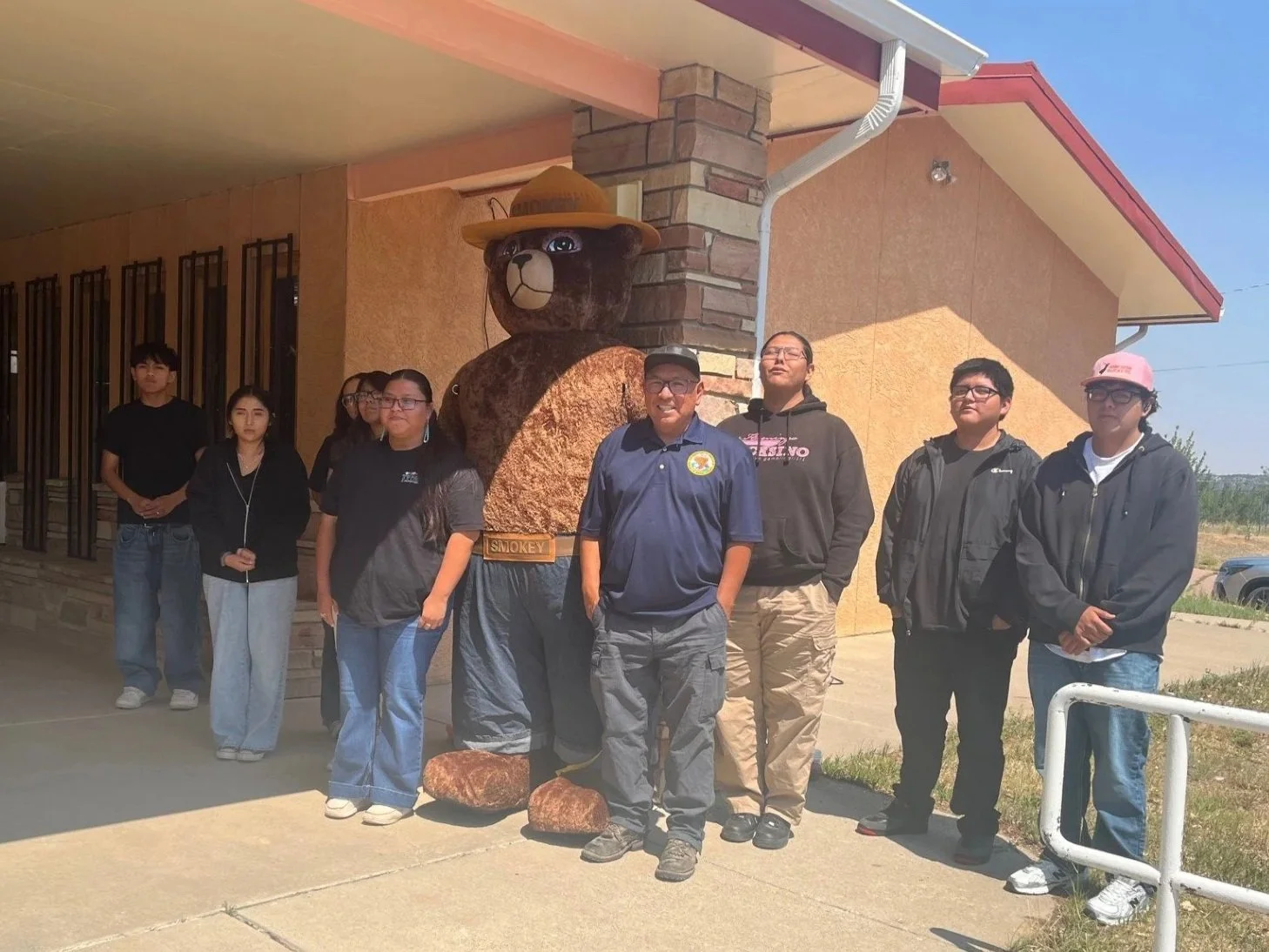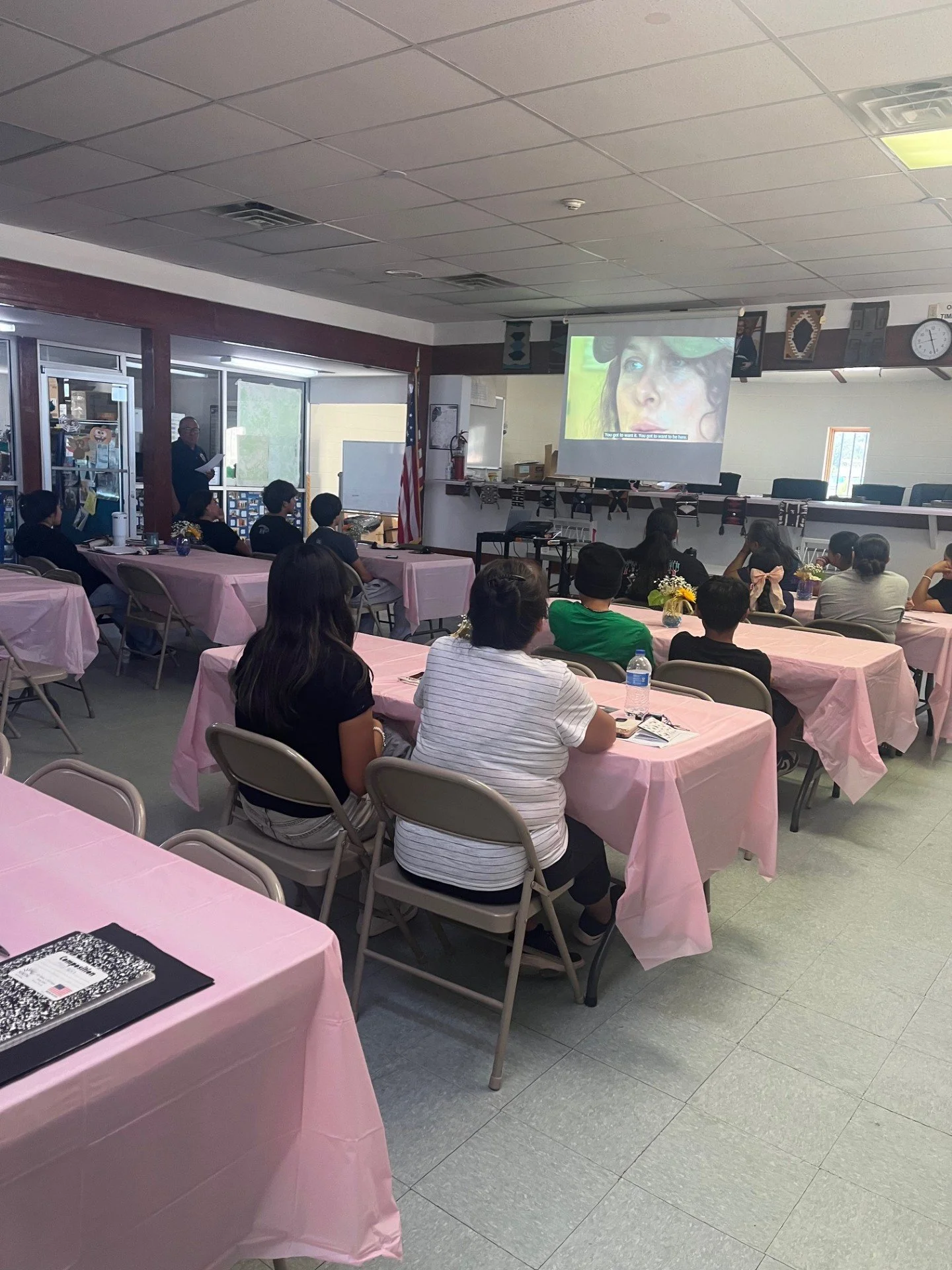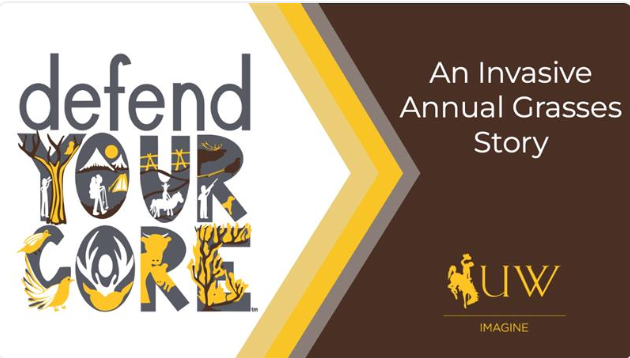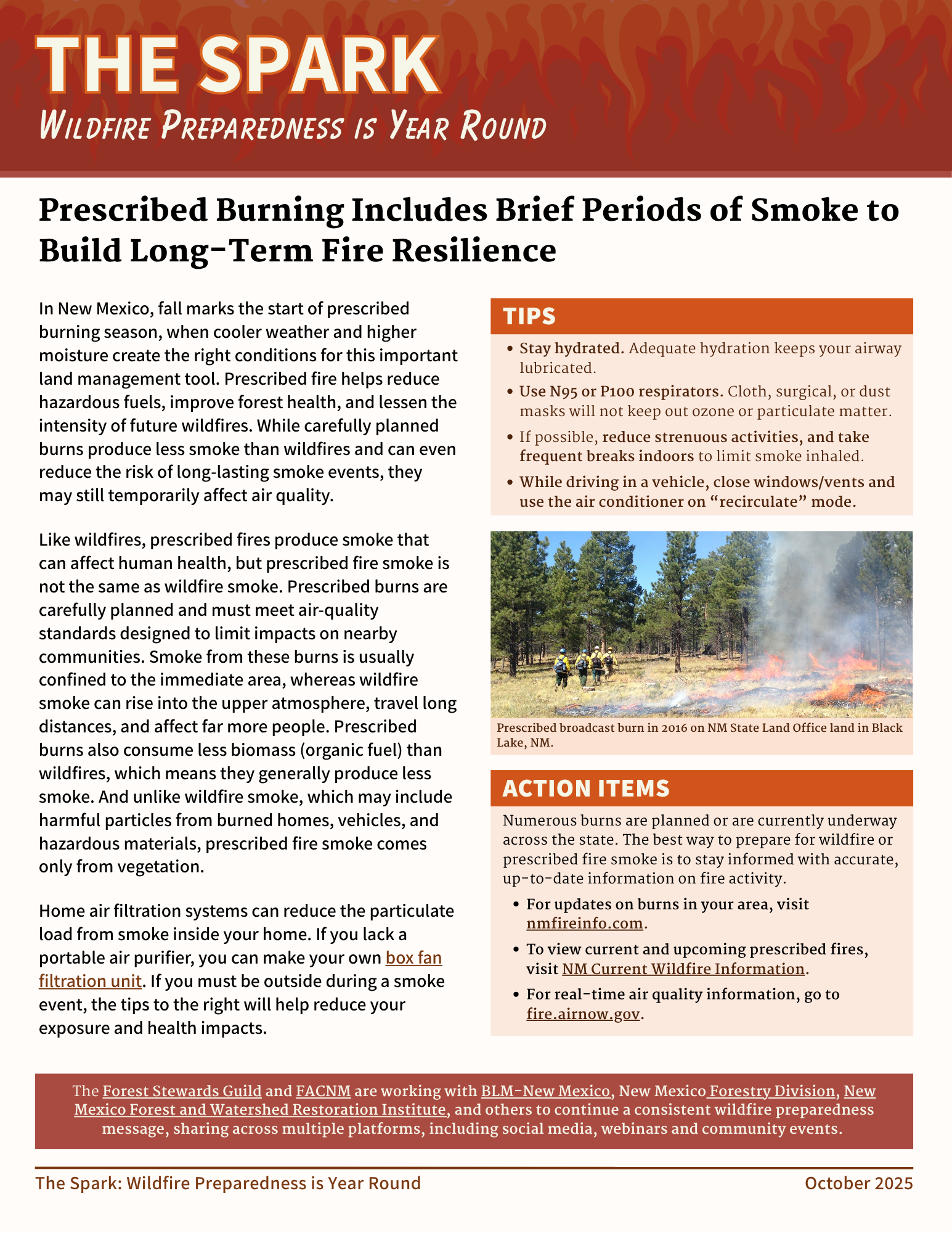Happy Wednesday FACNM community!
Today, we’re highlighting the work and insights of Gloria Skeet, Chapter Manager for the Bááháálí Chapter of the Navajo Nation. Alongside Gloria’s story, we’re sharing new resources, upcoming learning opportunities, and partner highlights to help support your own community’s wildfire adaptation journey.
This Wildfire Wednesday features:
Wishing everyone a safe and meaningful Día de los Muertos and a Happy Halloween,
Megan
October FACNM Leader Feature
Gloria Skeet serves as the Chapter Manager for the Bááháálí Chapter of the Navajo Nation, located south of Gallup, New Mexico, within the Eastern Navajo Agency. As an active member of the FACNM Network, Gloria has been instrumental in advancing wildfire preparedness and resilience through her leadership in the Zuni Mountains Collaborative and her efforts to implement McKinley County’s Community Wildfire Protection Plan (CWPP) goals within her community of Bááháálí.
Below, Gloria shares her experiences and key takeaways from guiding the Bááháálí community toward becoming more fire adapted and from her involvement with the FACNM Network.
Q: Describe a life experience that helped shape your dedication and/or passion for your current work in building fire adapted communities.
A: We were a family of ranchers and farmers so the land has always been a central part of my life and deeply important to my family. In Navajo culture, our prayers often begin with referencing our Mother Earth and Father Sun. Growing up Navajo means growing up with a strong connection to the land and the resources it provides. I grew up spending most of my childhood outside and when I moved back home, I never really thought of our area as a dense jungle of juniper and piñon.
When I started working at the chapter house, we were required to develop an emergency plan in case of a disaster. At first, I thought of disasters as things like earthquakes or tornadoes, but after the big fire in Taos, I realized that for our community, wildfire was our greatest risk. That moment opened my eyes to how unprepared our community was for wildfire.
Around that same time, I came across a flyer from McKinley County about developing a CWPP and decided to attend a meeting. At that meeting, I was the only Navajo chapter representative there and one of only three women in the room. That experience really changed my perspective.
Since then, I’ve been involved in the Zuni Mountain Collaborative and the annual meetings the Guild leads, where we work together to build resilience to wildfire in the region. Reading the county’s CWPP, I noticed that Baahaali was listed as one of three areas at high risk for wildfire, with Cibola National Forest right in our backyard. I also started focusing on how our chapter could implement some of the CWPP goals that hadn’t yet been addressed like improving roads that serve as escape routes. In our community, five county roads are listed in the plan, and I want to see Baahaali become one of the first Navajo communities to truly be fire adapted.
Q: When you think about your work in wildfire preparedness, what is your vision for your community?
A: At the grassroots level, my vision is for the community to really understand the role each person can play in reducing wildfire risk. That means getting their properties assessed for preparedness, doing thinning work around their homes, and helping their neighbors do the same.
Many Navajo families live in clusters, and everyone in those clusters is often related. Their homes and land are deeply important to them. When we can get the message across that each person can actively take steps to protect their home, and they start doing it, that’s what long-term success looks like to me. Community outreach is absolutely critical, and that’s where our work begins.
Q: What are one or two projects, partnerships, or efforts you’re especially proud of?
Darryl Wilson, Prevention Specialist, with Smokey Bear and attendees of a wildfire community education event.
A: One partnership I’m especially proud of is the work I’ve been doing with Darryl Wilson from the BIA Branch of Fire Management. I’ve learned a lot through that connection, especially since much of the Navajo Nation’s work hasn’t always reached the Eastern Agency, which is the only agency fully located in New Mexico. When I met with BIA Fire Management, I had the chance to connect with Darryl, who focuses on Home Hazard Assessments, and Dominick Chicharello, who does a lot of thinning work. Through them, I learned that we can accomplish a lot within our communities, but it often requires working directly with Navajo families who live on private land or have full land clearances.
I’ve also been working closely with our chapter for several years now, and I’ve realized that if something isn’t already built into the budget, you have to find partners to make it happen. Collaboration is key. We’ve built a strong partnership with the Zuni Mountain Collaborative, and Mateo, with the Forest Stewards Guild has been an incredible resource, providing technical assistance and helping us apply for a grant to become a wood hub. Working with Mateo and Juan at the Guild has helped us work with our community on the things we need to address most and learn about funding opportunities like the FACNM grant.
Q: What challenges or barriers have you faced in your work, and how have you worked through them?
A: We constantly face challenges, and they almost always come down to funding. You need money to get things done, so in many ways, money is both our biggest challenge and our biggest barrier.
Here at the chapter and in the work I’ve done, we’ve been able to work through this challenge because there’s always a partner out there willing to help. Overcoming financial barriers really comes down to knowing what resources are available, which means keeping communication open and building strong relationships. Those connections are what make it possible to keep moving forward, even when funding is tight.
Q: How has being a part of the FACNM Network supported or shaped your work?
A: Being part of the FACNM Network has been really valuable because it connects me with other communities and individuals doing similar work, and that network has been a huge support system. When you’re new to this kind of work, there’s so much to learn, and connecting with others helps you pick up those lessons faster because someone else has already gone through the same experiences. We’re able to learn from one another.
I also like to challenge myself to be my best, to help pave the way for others, and to spread the word about what’s possible. Many Navajo chapter communities don’t always realize the importance of having a wildfire protection plan for their community. I want to make sure they understand how important that is for their community and that they know about FACNM as a resource that can help them apply for funding and support outreach in their area.
Q: What advice would you give to someone stepping into a similar role or just beginning this work?
July 2025 community outreach event, held in partnership between the Baahaali Chapter House and BIA Wildland Fire Management - Navajo Region.
A: If you’re stepping into this kind of role, the first thing I’d say is to become aware of the resources that are already out there and find ways to access them.
If you want to be a change agent in your community, you have a responsibility to educate yourself. Seek out information, read, and reach out to people who are already doing this work. Ask questions and build your network. Don’t hesitate to ask if you can join a meeting or attend a workshop. There are so many resources available, you just have to take the initiative to find them and many of them are right in our own backyard.
It can take just one person to step forward and say, “Let’s go for it,” and that can open the door to a whole network of support.
Additional Resources and Upcoming Opportunities
Webinar: Tree-rings reveal the legacy of Indigenous cultural burning in the Southwest USA - November 5, 2020 at 12pm MT
In this webinar from the Southwest Fire Science Consortium, Dr. Christopher Roos and colleagues use published and unpublished tree-ring fire history records from pine forests in Arizona and New Mexico to demonstrate that Indigenous foragers, pastoralists, and farmers influenced Southwestern fire regimes in similar ways. This research shows that population size, culture, and economic organization were not limiting variables on the influence of Indigenous populations on fire regimes and that new methodological approaches may offer new insights into long histories of Indigenous fire stewardship that can contribute to discourse on contemporary fire management, fire-co-management, and restoration of traditional fire management practices.
Presenter: Dr. Christopher Roos, Professor of Anthropology and Earth Sciences, SMU
Presented by the Institute for Managing Annual Grasses Invading Natural Ecosystems, this film explores the impacts and options for managing invasive annual grasses (cheatgrass, ventenata, and medusahead). This film highlights the negative impacts of these grasses on landscapes and explores the ecological, ranching, and economic impacts in western rangelands. The stories in the film highlight how collective action and proactive solutions are making a difference for communities across the West. Hear from land managers who share their experiences with managing these invasive species through partnerships and collaboration. Learn about the best management tools and strategies, like herbicide application, restoration, and monitoring, for tackling this threat across different geographies.
To watch film, click here!
The Spark: Wildfire Preparedness is Year Round
About The Spark
The Spark is a unified, statewide messaging campaign that promotes year-round wildfire preparedness through consistent, coordinated outreach among partners each month.
Formerly known as “Wildfire Preparedness is Year-Round,” the campaign has returned with new energy and leadership. A core group of partners, including FACNM, BLM–New Mexico, NM State Forestry Division, and the New Mexico Forest and Watershed Restoration Institute (NMFWRI), will work together to deliver a monthly, unified wildfire preparedness message.
The bulletin below is designed to help you communicate wildfire topics to broad audiences.
October Edition
East Mountain Green Waste Days
Free drop-off for East Mountain Green Waste Days started Saturday, October 25, and runs through November 9. This is an opportunity for East Mountain residents to haul as much slash as you can to the Tijeras transfer station, free during this time period. This event is brought to you by Bernalillo County, County Commissioner Eric Olivas, Ciudad SWCD, and NM Association of Counties.
Ponderosa Pine Utilization Summit - November 18-20, in Flagstaff, AZ
The Summit will engage a diverse group of forest managers, industry leaders, researchers, and policymakers in strategic discussions that examine the state of ponderosa pine forests and industry in the western United States. Through case studies, intentional dialogue, and working sessions, attendees will identify key barriers, develop practical solutions, explore innovations, and determine the resources needed to stabilize and grow the utilization of ponderosa pine. Registration closes this Friday, October 31st so register before it is too late!
Agenda: View the draft agenda.
Registration Fee: $300 (includes all sessions, meals, reception, and Thursday field tour)
Register here.
S-212 Chainsaw Operations in Wildland Firefighting Course - Wildfire Resiliency Training Center, Luna Community College
On November 8-9 and November 15-16, the WRTC will be offering S-212 Chainsaw Operations in Wildland Firefighting. The course lessons provide introduction to the function, maintenance and use of internal combustion engine powered chainsaws, and their tactical wildland fire application. Field exercises support entry level training for firefighters with little or no previous experience in operating a chainsaw, providing hands-on cutting experience in surroundings similar to fireline situations.
Contact 505.454.5323 OR wschuchman@luna.edu to enroll.
